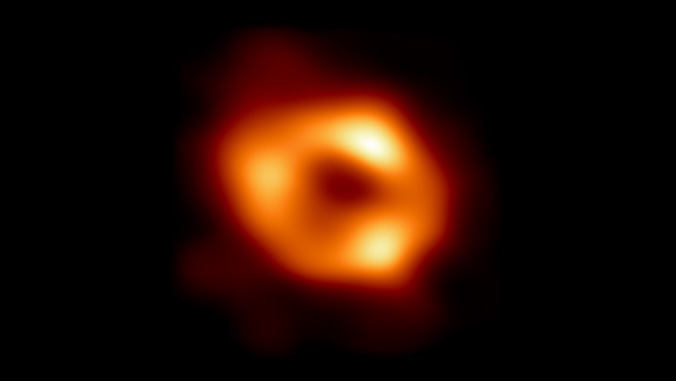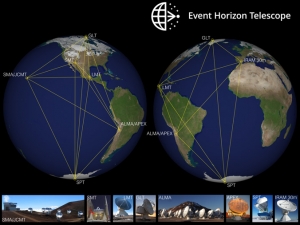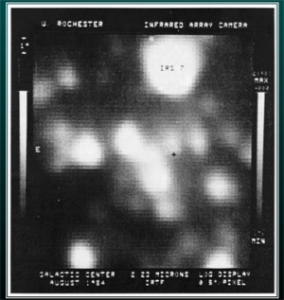
Astronomers have unveiled the first image of a supermassive black hole at the center of the Milky Way galaxy. This result provides overwhelming evidence that the object, 4-million-times more massive than the Sun, is indeed a black hole and yields valuable clues about the workings of such giants, which are thought to reside at the center of most galaxies. The image was produced by a global research team called the Event Horizon Telescope (EHT) Collaboration, using observations from a worldwide network of radio telescopes including the James Clerk Maxwell Telescope (JCMT) and the Submillimeter Array (SMA) on Maunakea.
“These unprecedented observations have greatly improved our understanding of what happens at the very centre of our galaxy, and offer new insights on how these giant black holes interact with their surroundings,” said Geoffrey Bower, an affiliate astronomer at the University of Hawaiʻi at Mānoa and EHT project scientist, who led Hawaiʻi operations for the Institute of Astronomy and Astrophysics, Academia Sinica, Taipei.

Scientists had previously seen stars orbiting around something invisible, compact and very massive in the heart of the Milky Way which strongly suggested that the object—known as Sagittarius A* (Sgr A*, pronounced “Sadge-A-star”)—was a black hole, and the long anticipated image provides the first direct visual evidence of it. Although the black hole is not visible, because it is completely dark, glowing gas around it reveals a telltale signature, a dark central region or shadow surrounded by a bright ring-like structure. The new view captures light bent by the powerful gravity of the black hole.
“We were stunned by how well the size of the ring agreed with predictions from Einstein’s Theory of General Relativity,” Bower explained.
The EHT team’s study, published in a special issue of The Astrophysical Journal Letters, shows the black hole is about 27,000 light-years away from Earth, and its size on the sky is about the same as a donut would appear on the Moon. To produce the image, the team linked together eight existing radio observatories from across the globe to form a single “Earth-sized” virtual telescope. JCMT and SMA, two of the world’s most powerful high frequency radio telescopes, provided coverage of the most western point. The collective “Earth-sized” virtual telescope observed Sgr A* on multiple nights, and collected data for many hours in a row, similar to using a long exposure time on a camera to record the gas moving quickly around the black hole.
In April 2017, the EHT project captured an image of Pōwehi, the world’s very first picture of a supermassive black hole at the center of the distant Messier 87 galaxy. The Milky Way’s newly imaged black hole is more than 1,000 times smaller and less massive than Pōwehi making it much more challenging to image.
Essential foundation
The first image of SgrA* demonstrates the critical role astronomical research in Hawaiʻi plays on a world-wide scale. In 2020, Maunakea astronomer Andrea Ghez earned a Nobel Prize for research that initially proved the existence and estimated the mass of the Milky Way’s supermassive black hole. Ghez used decades of data from the W.M. Keck Observatory on Hawaiʻi Island to examine orbits of stars around an invisible but massive compact object at the center of the galaxy.

In 1986, the UH Institute for Astronomy (IfA) operated Infrared Telescope Facility on Maunakea recorded the very first image of the Milky Way’s Galactic Center, which is the region about which our entire galaxy is rotating. That image set a vital foundation for understanding black holes and would eventually lead to the discovery of the bizarre objects in the midst.
“The fact that the first image of the Galactic Center was recorded from Maunakea, a critical early step in the marathon of research that now culminates in an image of the black hole that lurks in the core of our galaxy, is yet another testament to the revolution in knowledge Maunakea makes possible,” said Doug Simons, executive director at IfA.
Scientists are thrilled to now have access to images of two black holes of very different sizes. Work is underway to use the new data to test theories and models of how gas behaves around supermassive black holes. This process is not yet fully understood but is thought to play a key role in shaping the formation and evolution of galaxies.

